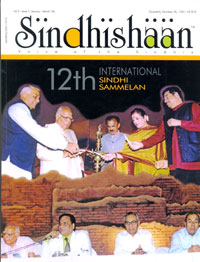FUNDING FACTS
By Arun Babani

The partitioned and displaced Sindhi community has had to keep the torch of Sindhiat aglow largely by it’s own efforts. With meagre government support and a general apathy from other social forces, this has meant collecting and spending funds with much hard work and discipline.
In the first two decades after partition, when the cost of living was comparatively low, it was largely a matter of collective funding. Remembers Mr. Kirat Babani, “In those days if there were 200 people assembled in a hall, each one of them would throw one or two or five rupee coin in a basket that went around the audience and we would pay the hall rent with a cup of tea and even a few wafers thrown in. Or the other way was that after each event was over, a couple of ladies would stand at the exit with a handkerchief in hands appealing for help for Sindhi newspapers, books and so on.” This was way back in the sixties.
Later when the rentals for the auditoriums rose, so did the printing costs, and with it came the new realities and new ways of funding plays and Mushairas was conceived. For instance, in the seventies when an evening at Tejpal hall cost Rs. 5000 or so, and with tickets sale being nil, a concept of having (hiring?) a chief guest came into fashion. Some Sindhi NRI (with white shoes and red socks!) would buy up all the front rows for his khandaan, and he would then be honoured during one of the two intervals with garlands and speeches. But soon problems arose so that the director and the cast of the play felt that the one hour for these ceremonies was far too long making the audience grow restless and leave half way through the play. So this chief guest system went against the very purpose for which it was invented.
Somewhat similar to the chief guest funding is the concept of sponsored funding, an example of which is the events held at Sita Sindhu Bhavan every alternate Sundays. It had an advantage over chief guest system who demanded a forty minute talk time at the mike, whereas the sponsor did not have any such demand. These pure Sindhi events lasting about two and half hours are usually sponsored by some donor who may be a rich businessman and are mostly in the memory of parents or beloved ones. A single program of music, dance and drama, followed by a simple Sindhi lunch may cost the sponsor around twenty thousand rupees. The events are popular and the Sindhi lunch with the Sindhi culture is a big temptation on an otherwise drab Sunday afternoon.
After the eighties the fund raising became more professionalized with both the fund raiser and fund donor becoming concerned about their own gains in the bargain. For instance, Indian Institute of Sindhology, having worked its way up by setting up the institute along with the infrastructure of houses, schools and so on, offered its donors a permanent place in the alumni or the trusteeship of the organization. So today each classroom, computer room, sports room is named after some or the other donor with their names at the entrance of each room. The donations are accepted for each unit, wing, block or room and are acknowledged on a marble plaque fitted on the top of each of these categories.
Some government sponsorships and funds too are allotted each year for the promotion of Sindhiat. Premier among these is the NCPSL (National Council for Promotion of Sindhi Language) an HRD Ministry fund which is as high as rupees one crore a year. This amount is usually not fully utilized for want of noteworthy projects. Similarly, the six states of Rajasthan, Gujarat, Delhi, Maharashtra, Kutch and Madhya Pradesh all have a Sindhi Academy supported with government funding. These Sindhi Academies utilize their yearly budgets in various projects ranging from seminars, land workshops, publishing books and holding events.
Akhil Bharat Sindhi Boli Ain Sahit Sabha is the oldest and the most prestigious of the Sindhi organizations which has been around the last 50 years or so. Major plus point of the Sabha is the prestige of its yearly awards with which it honours the Sindhi artists, teachers, journalists and so on. These awards which are over a dozen or so and valued at over rupees three lakhs are sponsored by well wishers of the Sabha and are the most sought after and valued by the community. The Sabha has so far honoured hundreds of deserving Sindhis and its funds come solely from friends and well wishers who trust the good work that the Sabha has been doing in the field of Sindhiat.
Another way of raising funds for Sindhi events has been the corporate advertising by Sindhi business houses like the Hiranandani builders who advertise frequently for all sorts of Sindhi events. The 12th International Sindhi Sammelam held in Mumbai in December proved that today Sindhis are prepared to actually pay for their entry into Sindhi events. There were around two thousand Sindhis in the three day event and thirteen hundred of them had paid their delegation fee. Gone are the days of donating your way into presiding on an occasion and expecting a bundle of free passes for your family. Realities have changed so much that today the need is of professionalized packaging of an event with each seat being paid for and each page being bought for a fair amount.
Culture is basically seen as a last priority on a shopping list, even after laundry or grocery or hosiery. And Sindhi culture is no exception to this worldwide phenomenon. But unless this trend is reversed and people perceive that learning and enjoying of culture is as important as food or clothing; unless they line up at the box office for their chance at an event celebrating Sindhiat, things will not improve much. Because unless there is a demand, fresh supply will not be created and it will continue to be like this; the same old Sindhiat - pale and worn out.
Sindhiat might then become like handicrafts or antiques valued only by foreigners, packaged and exported abroad to the Sindhis who are disgusted with their plastic surroundings.


